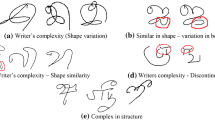Abstract
In our previous work, a so-called precision constrained Gaussian model (PCGM) was proposed for character modeling to design compact recognizers of handwritten Chinese characters. A maximum likelihood training procedure was developed to estimate model parameters from training data. In this paper, we extend the above-mentioned work by using minimum classification error (MCE) training to improve recognition accuracy and using both split vector quantization and scalar quantization techniques to further compress model parameters. Experimental results on a handwritten character recognition task with a vocabulary of 2,965 Kanji characters demonstrate that MCE-trained and compressed PCGM-based classifiers can achieve much higher recognition accuracies than their counterparts based on traditional modified quadratic discriminant function (MQDF) when the footprint of the classifiers has to be made very small, e.g., less than 2 MB.
Similar content being viewed by others
References
Axelord, S., Gopinath, R., Olsen, P.: Modeling with a subspace constraint on inverse covariance matrices. In: Proceedings of ICSLP-2002, pp. 2177–2180 (2002)
Axelord S., Goel V., Gopinath R.A., Olsen P.A., Visweswariah K.: Subspace constrained Gaussian mixture models for speech recognition. IEEE Trans. Speech Audio Process. 13(6), 1144–1160 (2005)
Bai, Z.-L., Huo, Q.: A study on the use of 8-directional features for online handwritten Chinese character recognition. In: Proceedings of ICDAR-2005, pp. 262–266 (2005)
Bai, Z.-L., Huo, Q.: An improved approach to extracting 8-directional features for online handwritten Chinese character recognition. unpublished manuscript (2005). See also, Z.-L. Bai, A study on a goal oriented detection and verification based approach for image and ink document analysis, Ph.D. Thesis, The University of Hong Kong, Chapter 6 (2006)
Bai, Z.-L., Huo, Q.: A study of nonlinear shape normalization for online handwritten Chinese character recognition: dot density vs. line density equalization. In: Proceedings of ICPR-2006, pp. 921–924 (2006)
Fahlman, S.E.: An empirical study of learning speed in back-propragation networks. Technical report, CMU-CS-88-162, Carnegie Mellon University (1988)
Gales M.J.F.: Semi-tied covariance matrices for hidden Markov models. IEEE Trans. Speech Audio Process. 7(3), 272–281 (1999)
Ge, Y., Huo, Q.: A comparative study of several modeling approaches for large vocabulary offline recognition of handwritten Chinese characters. In: Proceedings of ICPR-2002, vol. III, pp. 85–88 (2002)
Ge, Y., Huo, Q.: A study on the use of CDHMM for large vocabulary offline recognition of handwritten Chinese characters. In: Proceedings of 8th IWFHR, pp. 334–338 (2002)
Gersho A., Gray R.M.: Vector Quantization and Signal Compression. Springer, Berlin (1991)
Huo, Q., Ge, Y., Feng, Z.-D.: High performance Chinese OCR based on Gabor features, discriminative feature extraction and model training. In: Proceedings of ICASSP-2001, vol. III, pp. 1517–1520 (2001)
Juang B.-H., Chou W., Lee C.-H.: Minimum classification error rate methods for speech recognition. IEEE Trans. Speech Audio Process. 5(3), 257–265 (1997)
Kimura F., Takashina K., Tsuruoka S., Miyake Y.: Modified quadratic discriminant functions and the application to Chinese character recognition. IEEE Trans. PAMI 9, 149–153 (1987)
Linde Y., Buzo A., Gray R.: An algorithm for vector quantizer design. IEEE Trans. Commun. 28, 84–94 (1980)
Liu C.-L., Sako H., Fujisawa H.: Discriminative learning quadratic discriminant function for handwriting recognition. IEEE Trans. Neural Netw. 15(2), 430–444 (2004)
Liu, C.-L., Zhou, X.D.: Online Japanese character recognition using trajectory-based normalization and direction feature extraction. In: Proceedings of IWFHR-2006, pp. 217–222 (2006)
Long T., Jin L.-W.: Building compact MQDF classifier for large character set recognition by subspace distribution sharing. Pattern Recognit. 41(9), 2916–2925 (2008)
McDermott E., Hazen T.J., Le Roux J., Nakamura A., Katagiri S.: Discriminative training for large vocabulary speech recognition using minimum classification error. IEEE Trans. Audio Speech Lang. Process. 15(1), 203–223 (2007)
Nakagawa M., Matsumoto K.: Collection of on-line handwritten Japanese character pattern databases and their analysis. Int. J. Doc. Anal. Recognit. 7, 69–81 (2004)
Olsen, P.A., Gopinath, R.A.: Modeling inverse covariance matrices by basis expansion. In: Proceedings of ICASSP-2002, pp. 945–948 (2002)
Olsen P.A., Gopinath R.A.: Modeling inverse covaraince matrices by basis expansion. IEEE Trans. Speech Audio Process. 12(1), 37–46 (2004)
Sim, K.C., Gales, K.C.: Basis superposition precision matrix modeling for large vocabulary continuous speech recognition. In: Proceedings of ICASSP-2004, pp. 801–804 (2004)
Vanhoucke V., Sankar A.: Mixtures of inverse covariances. IEEE Trans. Speech Audio Process. 12(3), 250–264 (2004)
Wang, Y., Huo, Q.: A study of semi-tied covariance modeling for online handwritten Chinese character recognition. In: Proceedings of ICPR-2008 (2008)
Wang, Y., Huo, Q.: Modeling inverse covariance matrices by expansion of tied basis matrices for online handwritten Chinese character recognition. In: Proceedings of International Conference on Frontiers in Handwriting Recognition, pp. 284–289 (2008)
Wang Y., Huo Q.: Modeling inverse covariance matrices by expansion of tied basis matrices for online handwritten Chinese character recognition. Pattern Recognit. 42, 3296–3302 (2009)
Wang, Y., Huo, Q.: Design compact recognizers of handwritten Chinese characters using precision constrained Gaussian models, minimum classification error training and parameter compression. In: Proceedings of ICDAR-2009, pp. 36–40 (2009)
Author information
Authors and Affiliations
Corresponding author
Additional information
This work was done when Yongqiang Wang was a student intern at Microsoft Research Asia, Beijing, China.
Rights and permissions
About this article
Cite this article
Wang, Y., Huo, Q. Building compact recognizers of handwritten Chinese characters using precision constrained Gaussian model, minimum classification error training and parameter compression. IJDAR 14, 255–262 (2011). https://doi.org/10.1007/s10032-011-0153-9
Received:
Revised:
Accepted:
Published:
Issue Date:
DOI: https://doi.org/10.1007/s10032-011-0153-9




